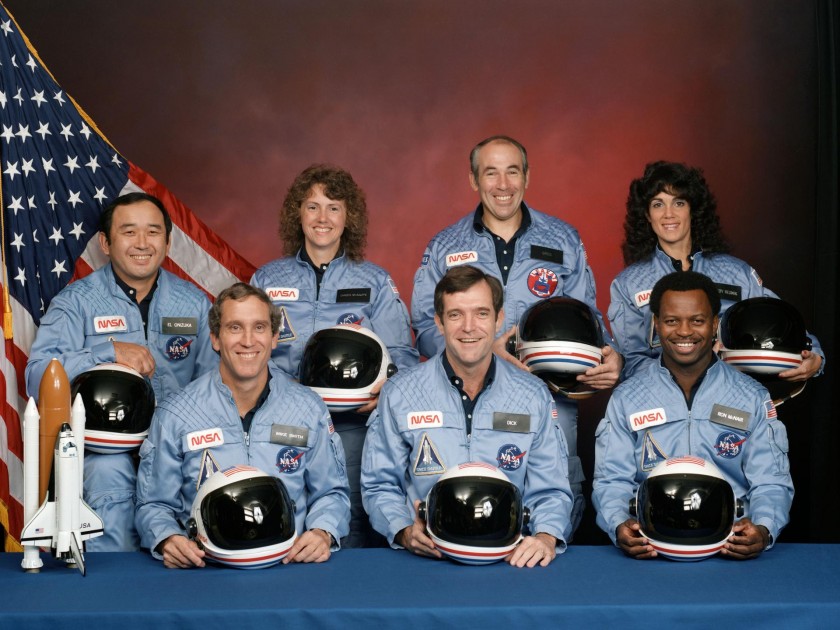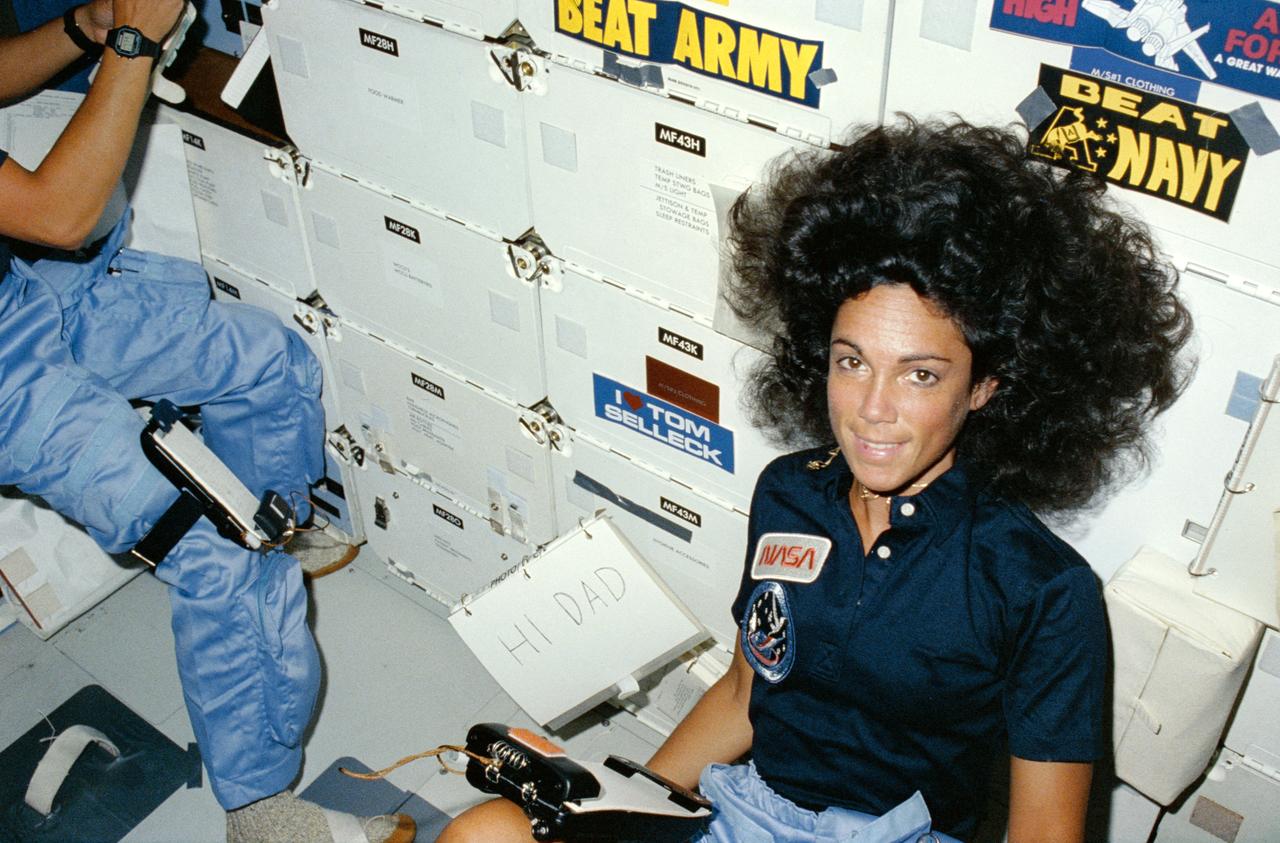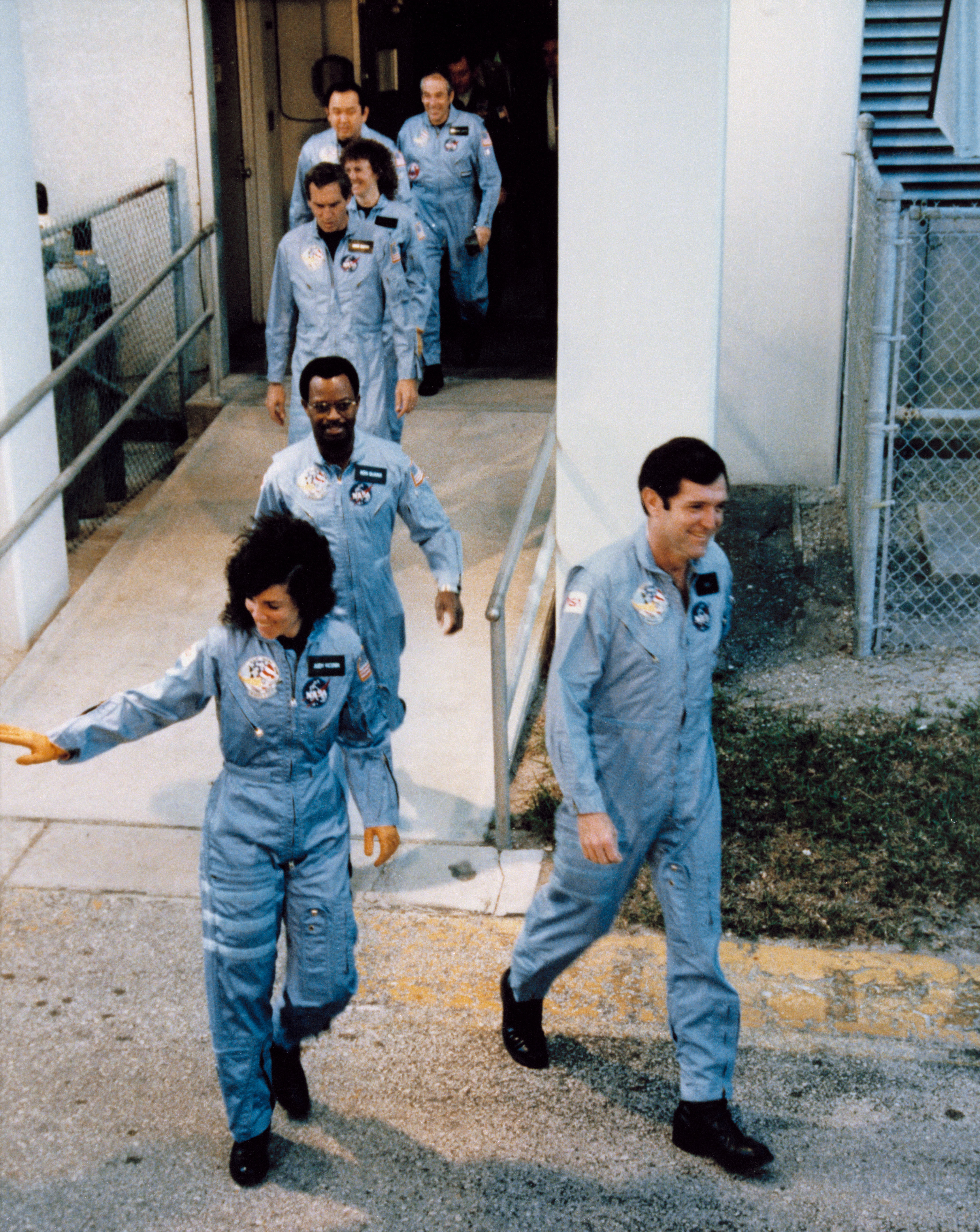
Challenger crew photo. Photo courtesy of NASA
Writing about a national tragedy can be a daunting task. One thing that kept me going during my work on The Burning Blue: The Untold Story of Christa McAuliffe and NASA’s Challenger Disaster was a duty I felt to tell readers about all seven members of the space-shuttle crew that launched from Cape Canaveral in 1986. Christa McAuliffe, who was chosen over more than 11,000 other applicants to be NASA’s “Teacher in Space,” became a celebrity in the run-up to the mission, but her crewmates were remarkable people, too.
Challenger commander Dick Scobee and pilot Mike Smith were red-hot flyers in the Chuck Yeager mold. Other aviators liked to say Scobee could land a paper airplane in a hurricane. The scientists onboard were brilliant, fascinating characters. Mission specialist Ellison Onizuka, the first Asian-American astronaut, was planning to study Halley’s Comet in ultraviolet light for the first time ever. Mission specialist Ronald McNair, one of NASA’s top laser physicists, was also a saxophonist (he gigged with touring musicians when they came through Houston) and a black belt in karate. McNair entertained at parties by smashing concrete blocks with a single chop of his bare hand. And then there was mission specialist Judith Resnik, an electrical engineer who was accustomed to being the smartest person in any room she entered, and who had what one admirer called, “the rightest stuff of them all.”
Judith Arlene Resnik grew up in Ohio; her father was an optometrist and served as a cantor in Akron’s Beth El Congregation. Marvin Resnik doted on his k’tanah‚ — his little one — showing her how to take radios apart and put them back together. Gifted in math and music, young Judith Resnik outperformed her piano teachers and considered studying at Juilliard. Instead, after scoring 1600 on her SAT exam — one of a handful of perfect scores recorded up to that time — she accepted a scholarship to Carnegie Tech (now Carnegie Mellon University), where she was one of three women in a freshman class of ninety students.
“Judy was brilliant,” recalls Mike Oldak, the college classmate she married in 1970. After graduating with honors she went directly into a Ph.D. program at the University of Maryland, skipping a master’s degree. “We both worked for RCA,” during their studies, he told me. “She got paid more than I did, and RCA applied for several patents based on her work.”
In 1984, Judith Resnik became the second female astronaut and first Jewish astronaut by flying in the space shuttle Discovery.
They divorced in 1974. “We wanted different things,” he says. Still they stayed close. Oldak was pleased when his ex-wife published a scholarly paper in the Journal of the Optical Society of America, titled “A Novel Rapid Scanning Microspectrophotometer and Its Use in Measuring Rhodopsin Photoproduct Pathways and Kinetics in Frog Retinas.” The details of how signals travel from frogs’ optic nerves to their brains got too technical for her optometrist father to follow, but he passed out copies to his friends.
At age twenty-eight, Dr. Judith Resnik was one of the most accomplished young electrical engineers in America. Seeking a new challenge, she applied to be an astronaut.
By then, NASA had sent seventy-three astronauts into space. All seventy-three were white men. Now the space agency wanted to diversify its ranks. It chose her as one of six women in the 1978 class of trainees. She and Sally Ride, a tennis champion with a Ph.D. in physics from Stanford, were considered the front-runners to be America’s first female astronaut. (But not the first woman in space — that was cosmonaut Valentina Tereshkova, who orbited Earth in 1963.) Marvin Resnik was disappointed when Ride was tabbed to fly first, but JR, as friends called her, was relieved. She loathed interviews and press conferences. Thus it was Ride who had to field reporters’ questions about makeup and bras in space. Once, when a newsman asked Ride if she cried when preflight simulations went awry, she nodded to shuttle pilot Rick Hauck and said, “Why doesn’t anyone ask Rick these questions?”
In 1984, Judith Resnik became the second female astronaut and first Jewish astronaut by flying in the space shuttle Discovery. She operated the shuttle’s 45-foot robot arm, plucking satellites from the cargo bay and dropping them into orbit. During a break between zero-gravity tasks she held up a sign for the TV cameras on the middeck: HI DAD.

From Judith Resnik’s first shuttle mission. Photo courtesy of NASA
By the time she was assigned to the Challenger crew two years later, shuttle flights seemed routine. The TV networks stopped covering them. “They should make it exciting,” Jerry Seinfeld joked. “Send up some guy that doesn’t want to go!” NASA drummed up interest with what it called the Spaceflight Participant Program, allowing civilians like Florida congressman Bill Nelson (now NASA’s top administrator) and Utah senator Jake Garn to fly into space as “payload specialists” on shuttle flights. The idea struck Resnik as a publicity stunt. “What are we supposed to do with these people?” she asked. The answer: Babysit them, and keep them from hitting the wrong switches.
“Teacher in Space” McAuliffe was by far the most famous member of the Challenger crew. She appeared on magazine covers and chatted with Johnny Carson on the Tonight show. But she struggled with the math she needed during training for their mission. Seeing how hard her crewmate was trying, Resnik took an engineer’s approach to the problem. She became an unofficial science tutor to the Teacher in Space.
They couldn’t have been more different, the intensely private scientist and the bubbly social-studies teacher, but they became friends. When a bunch of reporters mobbed Christa McAuliffe, her friend Judy told her, “You don’t have to put up with all this.” Christa laughed. “You don’t in your job, but I do in mine.”
Before they entered the capsule on the icy morning of January 28, 1986, mission specialist Resnik smiled and said, “Next time I see you, we’ll be in space!”
It didn’t turn out that way. Due to hardware problems NASA knew about but failed to prevent, the shuttle’s giant fuel tank exploded seventy-three seconds into the mission. The crew had no way to escape, but there is clear evidence that some or all of them acted heroically, trying to stay alive in the two minutes and forty-five seconds between the explosion and the moment the crew compartment crashed into the Atlantic at 207 miles per hour.
Today there are dozens of schools, city parks, and museums named after the Challenger astronauts. There are asteroids and lunar craters named in their honor. One of the most moving tributes came at a memorial service for Resnik in Akron where female astronauts including Sally Ride waved to a flyover by four NASA jets, using the American Sign Language signs for “I love you.”

Astronaut walkout with Commander Dick Scobee and Mission Specialist Judith Resnik leading the way to the Astrovan. Photo courtesy of NASA
The Burning Blue is Kevin Cook’s tenth book. He has written for The New York Times, The Wall Street Journal, GQ, Smithsonian and many other publications, and has often appeared on CNN and NPR. An Indiana native, he lives in Northampton, Massachusetts.